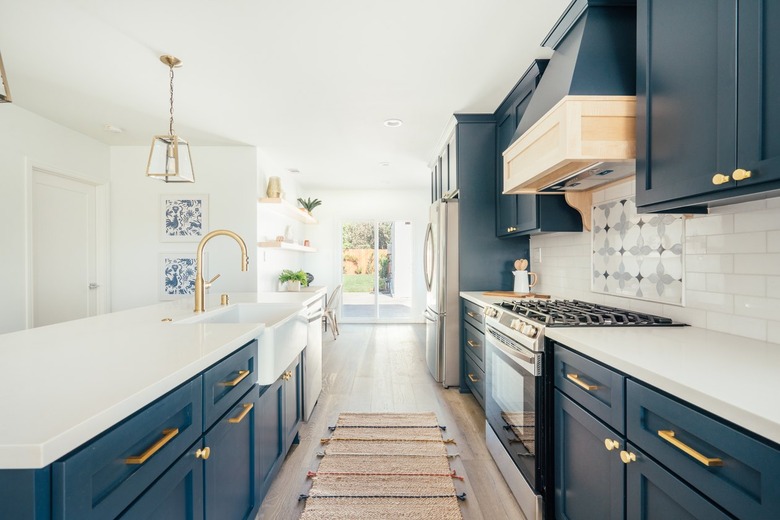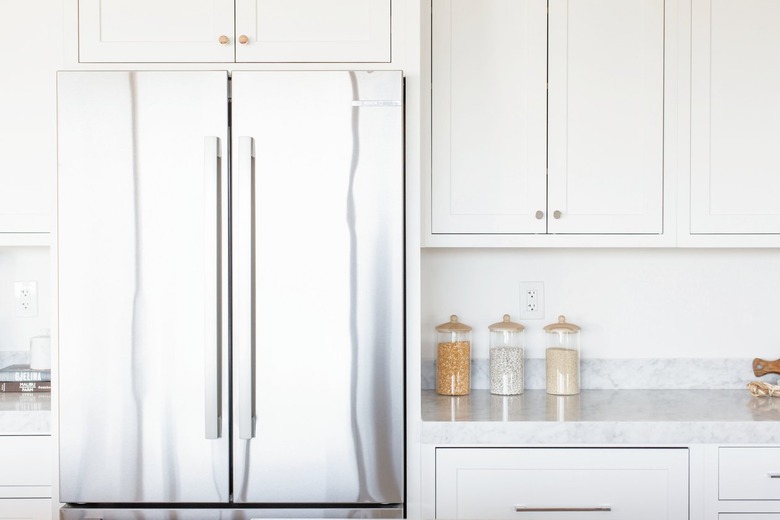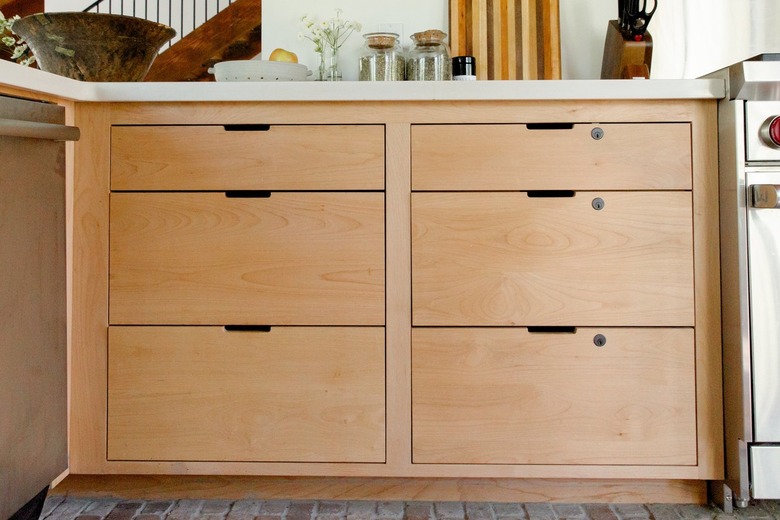How To Reface Your Kitchen Cabinets
Refacing cabinets is a cost-effective way to renew old cabinets with completely new surfaces and all-new doors and drawer fronts. In terms of cost, it's a big step up from painting old cabinets, but it's also a much more dramatic upgrade. And it can save you about 75 percent over the cost of full cabinet replacement.
While you can have refacing done by a company that specializes in this work, refacing is a reasonable DIY job. You don't need a lot of building or woodworking skills, but good results do require attention to detail and approaching each step with care. Plan on a few days of work so you don't rush the job and make mistakes.
How Cabinet Refacing Works
How Cabinet Refacing Works
A full cabinet refacing project involves removing the doors and drawer fronts, covering the exposed surfaces of the cabinet boxes with a thin wood veneer, then installing new doors and drawer fronts, plus any trim you'd like to add to complete the desired look. The veneer, doors and drawer fronts are sold together so they have matching wood and finish (as applicable). The veneer is real wood and comes in 2-by-8-foot sheets. You cut it into strips, stick them in place and trim them flush to the cabinet edge.
The veneer sheets can be pre-finished (to match the door stain and finish) or unfinished (you apply stain and finish of your choice). Traditional refacing involved adhering the veneer onto the cabinets with contact adhesive, but now many companies offer peel-and-stick veneer that you simply press in place. Different refacing kit suppliers have slightly different installation processes, so be sure to follow the instructions that come with your refacing materials.
Things Needed
-
Cabinet refacing kit
-
Drill with screwdriver bits
-
Sponge or rag
-
Dish soap or TSP (trisodium phosphate; or a TSP substitute)
-
150-grit sandpaper and sanding block
-
Auto body filler (as needed)
-
Putty knife (as needed)
-
Tack cloth or mineral spirits and rag
-
Tape measure
-
Pencil
-
Utility knife
-
Straightedge
-
Veneer scraper
-
Paper trimmer
-
Stain pen or color-matched wood filler (as needed)
-
Tools and supplies for installing trim (as needed)
-
Screws for drawer fronts
How to Reface Kitchen Cabinets
1. Clean the Cabinet Boxes
The project starts with emptying and cleaning the cabinet boxes. Remove all cabinet contents so they're not in the way and are protected from sanding dust later in the process.
- Remove the cabinet doors by unscrewing all of the hinges. If
you plan to reuse the hinges and other hardware, store them in a safe place. - Pull out all of the drawers from the cabinet boxes.
- Remove all contents from the cabinets.
- Clean the interior and exterior surfaces of the cabinets
with mild dish soap or TSP and water. Use a sponge or rag and keep it only slightly
damp at all times. Rinse with clean water.
2. Prepare the Refacing Surfaces
The cabinet surfaces that you reface must be smooth, flat and clean, with no bumps, raised edges or depressions.
- Lightly sand all surfaces to be refaced, using 150-grit
sandpaper and a sanding block. As you work, inspect the surfaces carefully for
bumps and depressions. - Sand down any bumps or other raised areas, including face
frame edges that extend past the sides of the cabinet box; all surfaces must be
flush. - Fill dents and other depressions with auto body filler (such
as Bondo), following the manufacturer's directions. Smooth the filler with a
putty knife and let it dry as directed, then sand the filler flush with the
surrounding wood surface. - Wipe the cabinets with a tack cloth or a rag slightly
dampened with mineral spirits. Do not use any cleaning solvent that may soften
the old cabinet finish.
3. Cover the End Panels
The exposed, finished ends of the cabinet runs typically are covered with a large sheet of veneer. Some kits may include thin plywood for the end panels, or you can opt to cover the ends with door panels that match the new cabinet doors.
- Measure and mark the veneer piece for each end panel, using one
of the long factory edges of the full veneer sheet. Mark the piece so it is
about 1/2 wider and 1 inch taller than the end panel. Tip: For vertical cabinet pieces, always orient the veneer so
the grain runs vertically. - Cut the veneer piece to size with a sharp utility knife and a
straightedge. - Peel away the non-stick backing along the factory edge of
the cut veneer. - Position the veneer with the factory edge against the wall, and
align the veneer so it overlaps the top and bottom of the cabinet by a roughly equal amount. - Stick the exposed veneer edge to the cabinet, and smooth it
with your hand, working up and down from the center. - Carefully peel away the remaining backing while smoothing
the veneer from the center outward. - Confirm that the veneer is properly positioned, then smooth
it thoroughly with a veneer scraper, working from the center outward and
smoothing with the grain of the wood. - Trim the overhanging edges of the veneer flush to the
cabinet edges, using a utility knife.
4. Cover the Cabinet Stiles
The stiles are the vertical pieces that make up the sides of the cabinet face frames. The standard process is to reface the stiles on all of the cabinets before moving on to the rails—the horizontal frame pieces. After the rails are covered, you will come back and fill in the final vertical pieces on any center supports (where the doors meet in the center on double-door cabinets). Alternatively, you can complete each cabinet one at a time, following the same order.
- Cut a strip of veneer for each cabinet stile, as before,
making it about 1/2 inch wider and 2 inches longer than the cabinet's stile. - Peel off the non-stick backing from one end of each strip.
- Position the strip so it is centered over the stile, overhanging
the edges equally side-to-side and top-to-bottom. - Press the strip onto the stile. Peel back the remaining backing
while smoothing the strip onto the stile with your hand. - Smooth the strip thoroughly with the veneer scraper, working
from one end of the strip to the other and moving with the wood grain. - Trim the strip flush to all edges of the cabinet with the
utility knife. Use a straightedge and the knife to trim the inside edge of the
strip at a straight line where it passes over frame rails and center supports.
5. Cover the Rails
The strips of rail veneer must be cut precisely to fit between the veneer strips on the stiles. Pros often use a paper trimmer to cut the rail strips to length. If you don't have a paper trimmer, you can use a utility knife and a straightedge or a square to ensure a straight cut.
- Cut each rail strip as you did with the stile strips, making them about
1/4 inch wider than the rail and at least 1 inch longer. - Position the strip into place, with one end butted tightly
against one of the adjoining stiles. Hold the rail strip in place and mark
where it meets the opposing stile edge. - Cut the rail strip to length at the mark, using a paper trimmer
or utility knife. - Test-fit the rail piece to ensure a snug fit. It should fit
while flat and not require bending to fit between the stiles. - Peel off the backing from the entire rail strip.
- Starting at one or both ends, as desired, fit the rail strip
into place, and smooth it with your hand, then with the veneer scraper. - Trim the rail strip flush with the rail's top and bottom
edges, using the utility knife.
Tip
When cutting the rail strips, orient them so the long edges are parallel to the wood grain. This will mean the grain runs horizontally when the strips are installed, mimicking the grain orientation of solid-wood rails.
6. Complete the Refacing
The final touches of the veneering process include filling in any center support strips, touching up veneer edges and adding optional trim. Some refacing kits include special stain pens and/or wood filler for final touch-ups.
- Cut, apply and trim veneer strips for all vertical center
supports, using the same techniques used for the rails. These pieces must be
cut to fit between the bottom and top rails of the cabinet frame. - Touch up any visible veneer edges or seams with a stain pen
or color-matched wood filler, as applicable. - Install decorative trim along the tops of the wall cabinets
and/or where cabinets meet walls, as desired.
7. Install the Doors and Drawer Fronts
New cabinet doors typically come with holes predrilled for new hinges. If you're reusing your old hinges, you will order the doors without holes predrilled.
-
Install the hinges on each cabinet door, using the
predrilled holes or drilling your own pilot holes (for reusing the old hinges). -
Add the door handles or pulls, as applicable.
-
Mount the doors onto the cabinets, as directed by the hinge
manufacturer. -
Adjust the hinges, as needed, to properly align each door.
Most new hinges are fully adjustable. -
Remove the old drawer fronts from the drawer boxes.
-
Install the new drawer fronts by centering each drawer box
over the backside of the new front and screwing through the front of the drawer
box and into the drawer front. -
Add the drawer handles or pulls, as applicable.
-
Fit the drawers into their slots to complete the project.
Tip
If your drawers have three-sided boxes that use the drawer front as the fourth side, you can keep the original front in place. Remove the drawer slides from the box, then saw off the side edges of the original drawer front flush with the box sides. Reverse the drawer end-for-end, and mount the new drawer front to what was the back end of the drawer. Reinstall the slides so they are oriented toward the new drawer front.


